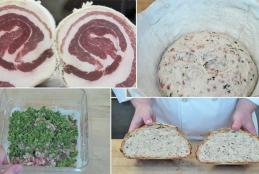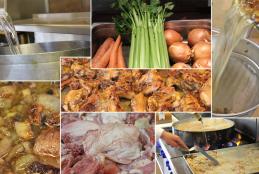ACJ 006| The Perfect Buffalo Chicken Wing
Sous chef Alex joins Chef Jacob in studio to discuss what exactly makes the best buffalo chicken wing.
Sous chef Alex joins Chef Jacob in studio to discuss what exactly makes the best buffalo chicken wing.
In this podcast episode, learn how a chicken's age and size affect it's flavor and texture.

Pancetta and parsley are a great, classic flavor pairing, and when combined with our standard sourdough boule recipe, yields a special, delicious bread. Use this bread to accompany soup, make a grilled cheese or just eat as is.
When I originally posted this recipe on Free Culinary School, it was a throw away post. I never thought that simple, braised chicken thighs would ever garner so much attention. It turned out to be my most re-created recipe and most commented post.

Basic recipe for chicken stock.
Tangy, spicy, smokey, and robust, this barbecue sauce is one of our favorites for smoked ribs.
A flavorful, French style gnocchi that is made from a savory pâte à choux base instead of the traditional potato, egg and flour mixture.
There are two kinds of veal stock; brown and white. The only differentiating factor is whether or not the bones are roasted. The decision to roast the bones is dependent on the final application of the veal stock. If you are making a traditional Veal Veloute, a white veal stock is needed.
In it’s most basic form, braising consists of a tough cut of meat with a lot of connective tissue, combined with liquid, aromatic vegetables and fresh herbs; this mixture is then cooked in a low oven until they becomes tender. The connective tissue responsible for the chewy texture is collagen, which is a triple helix of gelatin. When moisture along with slow, steady heat are applied, the triple helix unravels into three individual gelatin strands, leaving gaps in the muscle tissue it used to bind together, giving the impression of tenderness.
Rib Eye is one of my favorite steaks to cook and eat. In this video, I show you a simple preparation that calls for pan searing the steak on both sides, and then we end the video with a simple, mushroom reduction sauce.
As Spring transitions into Summer, stone fruits start to ripen and make an appearance at local markets. Since stone fruits and pork have an affinity with one-another, it seemed only natural when I went to cook dinner the other night and saw my favorite stone fruit from a local California farm; cherries! I grabbed a pork tenderloin, some fresh basil, a bottle of brandy and was ready to cook.
When it comes to roasting a whole chicken, this is my absolute favorite method to use. And although this approach is fairly simple, there are some finer points that you may want to examine if you're unfamiliar with process of spatchcocking.
Quick Correction: In this video, I refer to the technique applied to the chicken as Spatchcooking, when it's really Spatchcocking. I feel compelled to make a witty joke here, but I have to remind myself that we're not in a closed kitchen. Feel free to create your own punch lines...
In a previous video, I demonstrated how to bond two chicken breasts together using Activa RM. In this video I demonstrate how to bond two chicken leg and thigh portions together using an Activa GS slurry. This form of slurry allows for a tighter bond, making it ideal for large pieces of meat.
My preferred method of finishing is to cook the legs sous vide at 60C for four hours, which makes them extremely tender and juicy. After the fours, I'll ice bath to cool and then portion. For service, both sides of the leg and thigh are pan fried and then finished in the oven until the core temperature is warm.
In this video I demonstrate how to bind together two boneless, skinless chicken breasts using the transglutaminase enzyme. The resulting piece of meat is cohesive, easy to portion and will cook more evenly then a traditional chicken breast.
In this video, I demonstrate a classic version of white chicken stock. White stocks are commonly used for more subtlety flavored sauces, comsommes, and broths. It is also the base for the French Mother Sauce Veloute.
The technique of blanching bones before making a stock is commonly used in Asian cuisine, where a lot of recipes favor delicately flavored broths that are hard to achieve with roasted bones and mirepoix.
In a previous video, I demonstrated how to remove the thigh bone of a chicken hindquarter and while "Frenching" down the leg bone, which results in a semi boneless leg that you can then stuff. In this video, we'll go through a simple stuffing process and I'll demonstrate two different ways to actually cook the finished product.
This video will demonstrate how to take a hind quarter, remove the thigh bone and then "French" the leg bone. What results is a semi-boneless chicken leg and thigh that can then be stuffed with any number of delicious fillings and force meats. For part two of this video, which demonstrates the stuffing and cooking process, please refer to the first video listed in the "Related" section below.
In this video, we go over how to debone a chicken leg and thigh. Once deboned, the leg and thigh can be cooked flat, rolled into a roulade or even stuffed.
This video demonstrates how we prepare and cook our sous vide chicken breast that we're currently serving with sauted spring vegetables and a reduced shallot jus.
The chicken breast is first brined for 24 hours in a 5% brine and then rinsed. Next, the chicken breast is vacuum packed individually and cooked sous vide in 60ºC/140ºF water bath for 4 hours. On "the pickup," the chicken breast is cut out of the sous vide package and the skin is pressed into rice flour and then pan fried in chicken fat.
What makes this sous vide chicken breast great ...
Here's a quick video on how to pan roast a chicken breast. In this technique we use an airline chicken breast that is first brined, seared skin side down and finished in a hot oven without ever flipping.